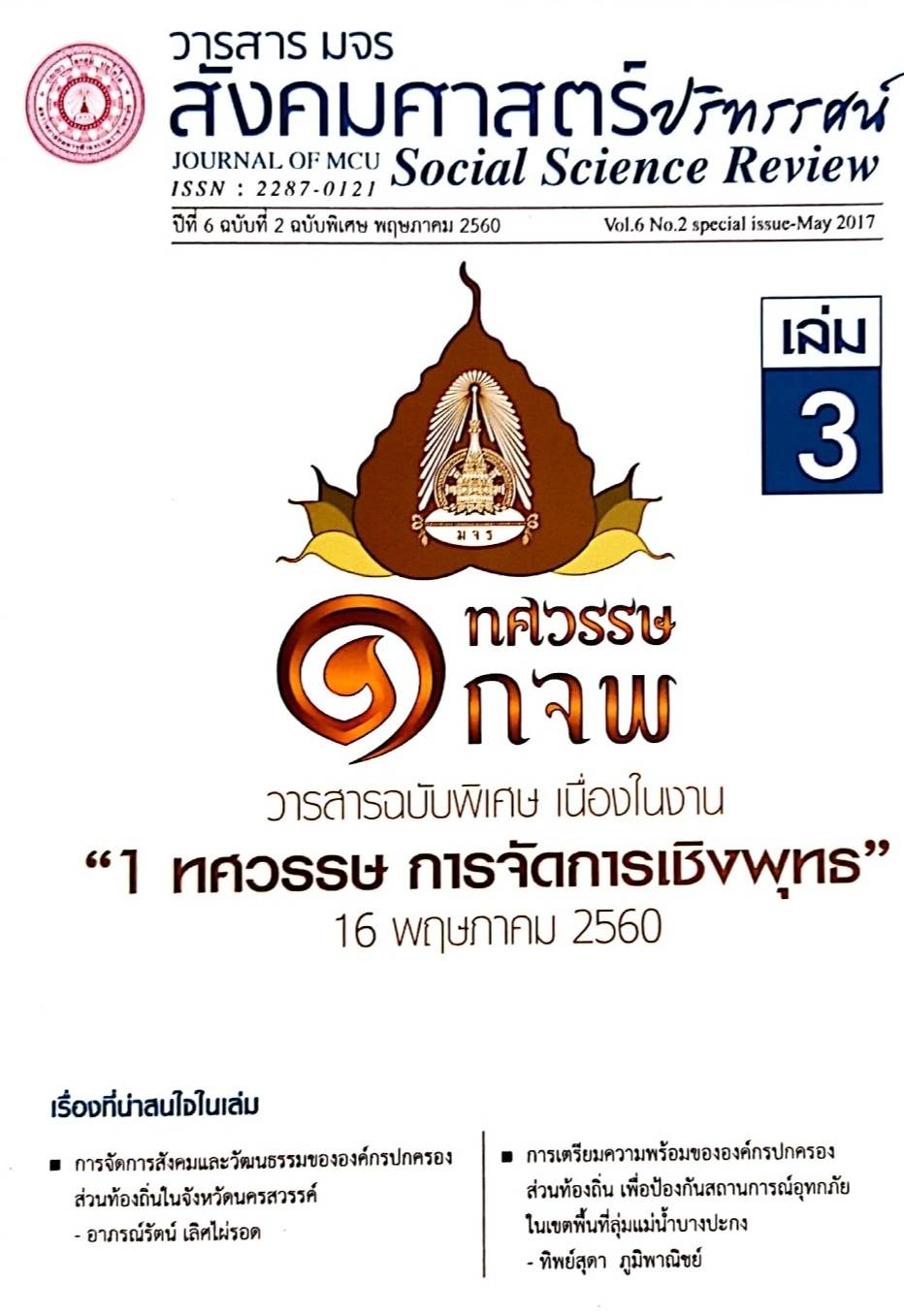การจัดการความขัดแย้งระหว่างประชาชนกับองค์การของรัฐโดยการอนุมัติโครงการ ด้านพลังงานชีวมวล ตำบลสีคิ้ว อำเภอสีคิ้ว จังหวัดนครราชสีมา
คำสำคัญ:
การจัดการความขัดแย้งระหว่างประชาชนกับองค์การของรัฐบทคัดย่อ
การวิจัยครั้งนี้มีวัตถุประสงค์ในการศึกษา 3 ประการคือ 1) เพื่อศึกษาสถานการณ์ความขัดแย้งในการดำเนินโครงการก่อสร้างโรงไฟฟ้าชีวมวล ตำบลสีคิ้ว อำเภอสีคิ้ว จังหวัดนครราชสีมา 2) เพื่อศึกษาบทบาทของหน่วยงานภาครัฐที่แสดงออกมาในการจัดการกับสถานการณ์ความขัดแย้ง
3) เสนอแนวทางการจัดการความขัดแย้งในการดำเนินโครงการก่อสร้างโรงไฟฟ้าชีวมวล ทั้งในระดับ ชาติและระดับท้องถิ่น เป็นการวิจัยเชิงคุณภาพ (Qualitative Research) โดยศึกษาวิเคราะห์ภายใต้ปรากฏการณ์ที่เกิดขึ้นจริง ด้วยวิธีการสัมภาษณ์เชิงลึก (In-depth Interview) กำรสนทนำกลุ่ม (Focus Group Discussion) การสังเกตแบบไม่มีส่วนร่วม (Non-Participant Observation)และ จากเอกสารทางวิชาการ เอกสาร รายงานต่าง ๆ รวมถึงงานวิจัยที่เกี่ยวข้อง มีผู้ให้ข้อมูลหลัก(Key information) จำนวน 35 คน โดยวิเคราะห์ข้อมูลอย่างเป็นระบบด้วยวิธีการพรรณนา เป็นการแปลความหมาย และสร้างข้อสรุปจากปรากฏการณ์ที่เกิดขึ้นมีข้อค้นพบโดยสรุป คือการสื่อสารที่เป็นทางการของหน่วยงานภาครัฐ ทำให้ประชาชนเกิดความไม่เข้าใจในกระบวนการและรายละเอียดของข้อมูลอย่างชัดเจน รวมถึงด้านผลประโยชน์ จึงไม่เชื่อมั่นในการบริหารงานของภาครัฐ ซึ่งได้กลายเป็นประเด็นความขัดแย้งของประชำชนกับหน่วยงานภาครัฐ
2. หน่วยงานภาครัฐล้มเหลวในการจัดการความขัดแย้งในการอนุมัติโครงการด้านพลังงาน เกิดจำกกระบวนการปฏิบัติตามนโยบายมีการละเมิดต่อสิทธิอันชอบธรรมของประชาชนโดยไม่เปิดโอกาสให้ประชาชนได้แสดงความคิดเห็น และขาดความสำคัญในกระบวนการมีส่วนร่มรวมทั้งไม่มีกระบวนกำรสร้างการรับรู้ ประชาชนจึงไม่เชื่อมั่น และไว้วางใจต่อหน่วยงานภาครัฐรวมทั้งภาคเอกชน
3. การปฏิบัติที่หลีกเลี่ยงหลักขั้นตอนของกฎหมายด้วยการอาศัยช่องว่างของกฎหมายและใช้ช่องทางของอำนาจที่มีอยู่ในการขอหรืออนุญาตให้ประกอบการกิจการพลังงาน โดยไม่มีการบังคับใช้กฎหมายอย่างเคร่งครัด ทำให้มีโรงไฟฟ้าชีวมวลเกิดขึ้นจำนวนมากและส่งผลกระทบการจัดการความขัดแย้งของประชาชนกับหน่วยงานภาครัฐในการอนุมัติโครงการด้านพลังงาน จึงประกอบด้วย ความไว้วางใจ การสร้างสรรค์สังคม และข้อเสนอทางเลือก โดยการเปิดพื้นที่ทางสังคมเพื่อการสร้างความไว้วางใจ เปิดโอกาสการเข้าไปมีส่วนร่วมในทุกขั้นตอน โดยที่ทุฝ่ายยอมรับและมีเป้าหมายร่วมกัน รวมทั้งข้อเสนอทางเลือกที่หลากหลายเป็นทำงออก และโยงยึดกับหลักธรรมาภิบาล และความรับผิดชอบต่อสังคมเป็นฐานหลักสำคัญ
เอกสารอ้างอิง
Arnstein, Sherry R. (1969). A Ladder of Citizen Participation.Journal of the American Planning Association.35 (4)(July): p. 216-224.
Creighton, J. L. (2005, p. 7). The Public Participation Handbook: Making Better Decisions Through Citizen Involvement. San Francisco: Jossey Bass.
Christopher Moor. (1996, p.60–61). The Mediation Process: Practical Strategic forResolving Conflict. (2nd ed). San Francisco, CA: Jossey-Bass.
Denhardt, Janet V. and Denhardt, Robert B. (2007).The New Public Service :Serving, Not Steering.(Expanded ed).New York: M.E. Sharpe. USA.
Osborne, D. and Gaebler, T. (1992). Reinventing Government: How the entrepreneurial spirit is transforming the public sector. Wokingham: Addison-Wesley.
Pateman, Carole. (1970).Participation and Democratic Theory.Cambridge University Press.
Prause, Daria. andMujtaba, Bahaudin G. (2015). Conflict Management Practices for Diverse Workplaces. Journal of Business Studies Quarterly.6 (3) (2015).
ดาวน์โหลด
เผยแพร่แล้ว
รูปแบบการอ้างอิง
ฉบับ
ประเภทบทความ
สัญญาอนุญาต
ลิขสิทธิ์ (c) 2020 วารสาร มจร สังคมศาสตร์ปริทรรศน์

อนุญาตภายใต้เงื่อนไข Creative Commons Attribution-NonCommercial-NoDerivatives 4.0 International License.
เพื่อให้เป็นไปตามกฎหมายลิขสิทธิ์ ผู้นิพนธ์ทุกท่านต้องลงลายมือชื่อในแบบฟอร์มใบมอบลิขสิทธิ์บทความให้แก่วารสารฯ พร้อมกับบทความต้นฉบับที่ได้แก้ไขครั้งสุดท้าย นอกจากนี้ ผู้นิพนธ์ทุกท่านต้องยืนยันว่าบทความต้นฉบับที่ส่งมาตีพิมพ์นั้น ได้ส่งมาตีพิมพ์เฉพาะในวารสาร มจร สังคมศาสตร์ปริทรรศน์ เพียงแห่งเดียวเท่านั้น หากมีการใช้ภาพหรือตารางหรือเนื้อหาอื่นๆ ของผู้นิพนธ์อื่นที่ปรากฏในสิ่งตีพิมพ์อื่นมาแล้ว ผู้นิพนธ์ต้องขออนุญาตเจ้าของลิขสิทธิ์ก่อน พร้อมทั้งแสดงหนังสือที่ได้รับการยินยอมต่อบรรณาธิการ ก่อนที่บทความจะได้รับการตีพิมพ์ หากไม่เป็นไปตามข้อกำหนดเบื้องต้น ทางวารสารจะถอดบทความของท่านออกโดยไม่มีข้อยกเว้นใดๆ ทั้งสิ้น





